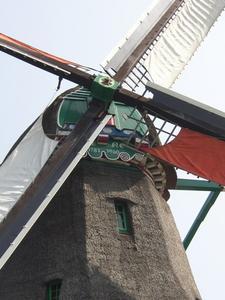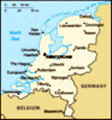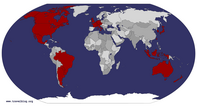Advertisement
Published: January 23rd 2006

 Dutch windmill
Dutch windmill
Closeup look at a working Dutch windmill, Zaanse Schans.Well, tell you what. I have relatives in the Netherlands, and this trip is a good opportunity to reconnect with my other side of family.
Dad is the youngest of all seven kids; Grandpa and my oldest uncle were killed in the 1940s during Japanese occupation when dad was three years old. Twako (lit. means “the oldest aunt” in Chinese Fujian dialek) is the oldest sibling, and she took care of the rest of the kids, and she naturally became a second mother for my dad. During the Indonesian revolution in 1960s, she, along with another aunt, immigrated to the Netherlands with all of their family of total seven children. Twako has four kids, Ci Irene (my dad’s old playing mate before she moved to the Netherlands), Ci Wie Mei, and Ko Maarten, all of whom I have met prior to the visit to the Netherlands, and Ci Linda of the youngest, who was born in the Netherlands. In our culture, addition “Ci” (lit. mean “big sister”) is added in front of one’s name in order to show respect, and “Ko” (“big brother”) is for the male counterpart.
Ci Irene was nine years old when she moved to the

 Amsterdam canal
Amsterdam canal
A narrow Amsterdam architecture style row of houses.Netherlands. She married Ko Sing, now both are dentists, and are blessed with a set of twin, Dane and Darryl, fifteen year old funny lads. They are our dear hosts during our stay in the Netherlands, by letting us stay in their home in Zaandam, and showing us around the country.
Zaandam is a suburb of greater Amsterdam, about half an hour of train ride from Amsterdam Centraal. Ci Irene and Ko Sing were meeting us at the Zaandam Centraal, driving two separate cars to accommodate all five of us and our belongings. Their house is a typical contemporary European home, with sleek design and many artifacts collection from their traveling. There are even two wayang golek from Yogyakarta, Indonesia! Ci Irene loves Japanese crafts and an excellent painter herself, having several Japanese style art all around the house. Dane/Darryl, the twins, are busy with the other set of twins of Ryan/Jason, and both sets are examining each other set in delight, so as a result, we put them all on a couch for us to watch.
Ko Maarten and his pregnant wife Ci Ivone, Ci Linda and Twako are gathering at Ci Irene’s house for our first

 Zaanse Schans
Zaanse Schans
A row of windmills, from the river's perspective.night, catching up with our lives and having an excellent Indonesian style BBQ together. It is amazing to realize on how many languages all of us are speaking at the house - Twako and I are talking in Indonesian, Twako and the rest of the family are talking in Dutch, and anything else involving Ryan and Jason are in English.
Amazingly, there are many elements in Dutch cultures that are similar with Indonesian, as the two cultures are complimenting each other during the three and a half centuries Dutch occupation in Indonesia. The two cultures are complimenting each other in almost all aspects, including language, custom and food ingredients. Some slang and terminology of Indonesian and Dutch are similar, and many older generation Dutch can speak Indonesian and vice versa.
Breakfast ala Dutch was different for sure. We started with a bowl of soup, then bread with butter with chocolate sprinklers, and some Nutella chocolate spread.
There is one thing that bugs us on this trip in the Netherlands. Literally. Mosquitoes have eaten us alive, especially at the Hardy boys’ skin where red dots appear everywhere. According to Ryan’s famous theory, the Netherlands was built on swamps

 Klompen for sale
Klompen for sale
These shoes are made for walking! NOTand therefore, lots of canals and other bodies of water where mosquitoes can breed and multiply.
Rembrandt and van Gogh captured some of the typical Dutch country landscape in their masterpieces, such as in the Zaanse Schans, a touristy town (unfortunately) about 10 miles outskirt of greater Amsterdam. Dutch culture is often associated with the use of windmills, mainly to dry off swamps for agricultural land and to produce food and other materials. At one point around 18th century, Zaanse Schans claimed to have more than 1,000 operating windmills and became the center of windmill technology of the Netherlands. Today, only historical 13 windmills left standing, served as living history museums that still producing several items, as they have been for centuries. De Kat proudly entitles to be the oldest surviving windmill, still making paint colors inside the 17th century original wood structure. My favorite is the De Zoeker, which is still actively producing oil. Observers are invited to climb up inside the wood structure, examining on how a traditional Dutch windmill produces such power to generate power by wind blowing through its four canvas blades.
See how touristy the town is, Ryan and Jason bought some tulip

 Two sets of twins
Two sets of twins
We managed to put the two sets of twins side by side.bulbs for their mom and sister for €3.75 each from a gift shop, packed in plastic packages complete with custom certificates. Meanwhile, I’m more interested in learning that our boat driver is one of Ko Sing’s patients. This ride around Zaanse Schans on boat completes the set of ‘ways to see Europe transportation’: from small plane of RyanAir, big plane of American Airlines, Eurorail, Roman tram, on foot, bus, car, moped in Milan, and traghetto in Venice.
Dutch obsession to reclaim more dry land from the sea has been creating many major changes to the landscape and the old way of custom operated. Zuider Zee holds the record to top it all, with a 32km (about 20 miles) long Afsluitdijk (Enclosure Dike) completed in 1932, which is viewed as the longest dam in the world and as an extraordinary piece of civil engineering to protect the low-lying land from the ravages of the open seas. The dam disconnected the rough North Sea from an inlet sea, called Ijsselmeer, which becomes somewhat fresh water overtime. By draining the water out to the North Sea, more dry land inside Ijsselmeer is to be reclaimed for agriculture and housing purposes. On a
clear day, driving halfway the road completed in early 1970s connecting two points across the dam, you can reach an observation tower deck that provides an excellent spot to observe the water level difference between two bodies of water.
Unfortunately, many traditional fisherman villages along Ijsselmeer had to change their centuries’ ways of life due to the enclosure. Volendam, for an example, was once home to the Dutch fishing fleets and the adventurous captains of the Dutch Golden Age who traveled to the East and West Indies and beyond. Afsluitdijk has forced them to disband the old fishing life, and as the result, Volendam now is a touristy place that sells tourist package on photo shooting in traditional Dutch costumes. Many locals are dressing up in traditional clothing, including klompen (wooden shoes). Traditional Dutch costume is interesting; men wear dark baggy pantaloons fastened with silver guilders instead of buttons, striped vests, and dark jackets with caps. Women wear long dark skirts covered with striped aprons and blouses with elaborately hand-embroidered floral panels. Their coral necklaces and famous winged lace caps complete the picture. Twako and Ci Linda gave a present by having us posed in the costumes, as a

 Amsterdam architecture
Amsterdam architecture
A narrow Amsterdam style row of houses.cheesy touristy thing to do in Volendam.
Twako is an excellent chef, and she owns an Indonesian restaurant “Toko” in Amsterdam, which is portrayed to be an exotic and high class food in the Netherlands.
As expected, by the end of the fiesta, we were so stuffed that made us so relaxed and tired. But still, there were many food left: many bacang (stuffed flavored rice with grounded meat in the middle, wrapped in a bamboo leaf and steamed), lychee, jackfruit, and some Dutch desserts.
For dinner, we drove to Amsterdam to Twako's house, and for the first time, I visited her single living unit. Her condo was a smaller, comfortable size for her and Ci Linda, and reflected the typical modern European living unit. After a while checking out her place, we walked to a nearby Middle Eastern restaurant owned by an Egyptian family, where I was reminded again, how closed the Dutch culture with Indonesian. Even though it was a "Dutch/Middle Eastern" restaurant, but I believe Satay Ayam (Chicken satay with peanut sauce) is neither; it is a traditional Indonesian dish. With delight, I chose the Satay meal for dinner, along with a can of

 Anne Frank bookcase
Anne Frank bookcase
The world famous book shelf, Anne Frank house.Coke (no refill) and kept getting to know my relatives here even more. It was a perfect meal for a perfect, happy day.
I'm not even sure what is the most famous thing in Amsterdam: tall narrow houses along the canals, van Gogh, Anne Frank, Rembrandt, legalized drugs and prostitute, or Red Light District. Everything is so laid back and becomes part of the daily life here in Amsterdam, and even the Dutch never thought of how much different is Amsterdam than the rest of the world.
Houses were built upwards, a prototype of modern skyscrappers. At the top of the structure, they have a pulley system to haul heavy stuff, such as piano and bed frames, to the top of the structure through windows. Unfortunately I didn't encounter any of the hauling activities that day.
As a landscape architecture student, I learn that the Netherlands has one of the best biking systems in the world. Dutch government developed many intensive bike paths throughout the small country, which are separated from the motorized traffic.
Anne Frank Huis is one of the busiest tourist spots in Amsterdam; however, we went in almost instantly after waiting in line

 HRC Amsterdam
HRC Amsterdam
A chess piazza in front of the HRC Amsterdam.for a short time. This house was converted into a museum to preserve the horrific memories of the Holocaust, as Anne Frank and her family were hiding at the narrow house for a couple of years before got captured and sent to concentration camps. It was very dark inside the museum as all windows are all shut, helps to set up the mood of comprehending how it feels like living as a Jewish in Amsterdam at Nazi regime. The famous hiding bookshelf is on the display, tourists can proceed by going upstairs through the secret passageway.
What is a visit to Amsterdam without experiencing the Red Light District? At the first glimpse, nothing separates the District from the rest of the city: idyllic canals, tall narrow brick houses, and cobble stoned roads.
But as soon as you look around and find the XXX bollards all over the place, you know right away that you're in a special place. Thus, the "XXX" term is famous throughout the world as the sex symbol, starting from the Red Light District in Amsterdam. Everything unthinkable is in the District, starting from window shopping for half naked girls, hemp museum, "coffee shop", penis

 Yo mon
Yo mon
Weed, Amsterdam style.fountain, and people offered you drugs. Talking about being liberal.
The Dutch government made a smart move legalizing all of the unthinkable. Amsterdam is not safer or more dangerous to anyone more than any other major cities, government is making money out of taxed professional prostitution, drugs and mariyuana, and tourists are attracted to visit Amsterdam, thus creates more economy to the city.
Advertisement
Tot: 0.137s; Tpl: 0.014s; cc: 11; qc: 29; dbt: 0.0445s; 1; m:domysql w:travelblog (10.17.0.13); sld: 1;
; mem: 1.1mb





















sexmaster
non-member comment
Horray
i love the red light district that club looks fun i love sex and i would hug that fountain penis' are amazing thank you for the pix